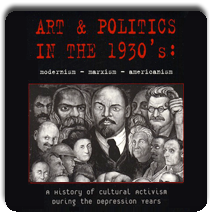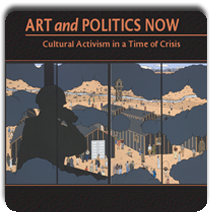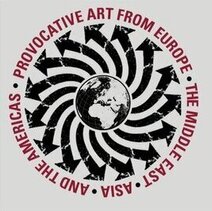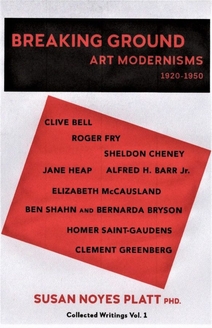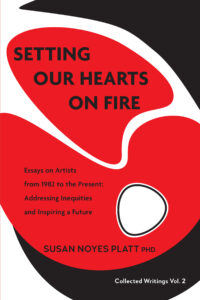Salvador Dali: Disruption and Devotion
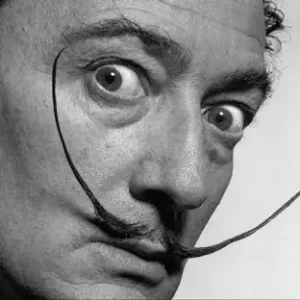
A Visiting Contributor!
Pamela Allara is an art historian and critic who lives in Boston.
Salvador Dali, Disruption and Devotion
Museum of Fine Arts, Boston
July 6-December 1, 2024
If someone had told me in the 1970s that someday that I would write that Salvador Dali is not only an outstanding painter but occasionally even profound, I would have laughed in your face. That self-promoter? Interested only in how much he could earn from paintings of his that were sold? I argued then that his paintings are superficial and he is the least important member of the Surrealist movement, wondering if he should be included at all. After all, he was characterized as a showman and cast out of the Surrealist movement by Andre Breton in 1939. Never chastened, he declared “I believe I am the savior of modern art,” in 1963, a date when one might argue that modernism was already at its end. In 1971 Dali showed up for an interview on the Dick Cavett show with an anteater on a leash. He remained a showman until his death in 1989.Yet, the work remains well worth viewing. I have revised my long-held negative assessment of this artist.
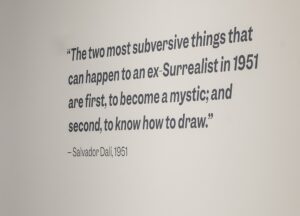
Dalí: Disruption and Devotion
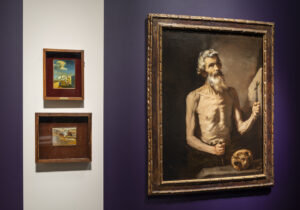
Dalí: Disruption and Devotion
“Salvador Dali, Disruption and Devotion” at the MFA Boston charts the seemingly contradictory paths of his career, from an artist calling for overturning the status quo in art to creating devotional panels testifying to his Catholic faith. Curated by Frederick Ilchman, Chair of European Paintings at the museum, it consists of 30 paintings from the Salvador Dali Museum in St. Petersburg, Florida.
To repeat, despite Dali’s bombast, the exhibit contains excellent work that revives his artistic reputation. In 1949, he met with Pope Pius XII, and renewed his interest in the Catholic faith, and in 1951 traveled across the U.S. lecturing on nuclear mysticism, whatever that may mean.
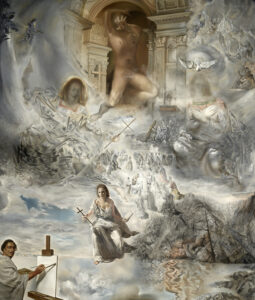
The Ecumenical Council
The largest painting in the current exhibition is “The Ecumenical Council,” from 1960, which includes a naked God, a ‘nuclear’ Virgin Mary, and wife Gala leading the viewer into this strange paradise. Dali is in the left-hand corner recording the whole scene of course. It is the worst painting in the otherwise excellent exhibition. Judge for yourself, it can also be found on the MFA’s website Of course, it earned the most selfies.
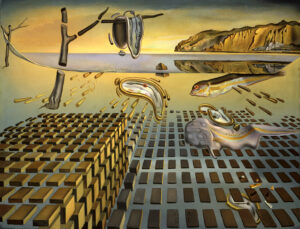
fig 1The Disintegration of the Persistance of Memory
But the smaller paintings can truly disrupt and disturb. The exhibit begins with “The Disintegration of the Persistence of Memory,” from 1952-4, fig. 1. (His most famous painting, MoMA’s “The Persistence of Memory” is not included in the exhibit). Here is the familiar vast landscape and the melting watches from the original, but it is a more mechanized landscape, with what look like missiles shooting toward the horizon. This work is less about memory than a contemporary apocalypse.
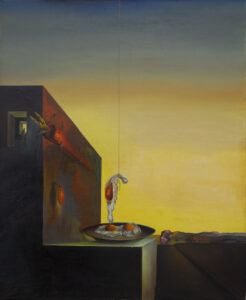
fig 2 Eggs on the Plate Without the Plate
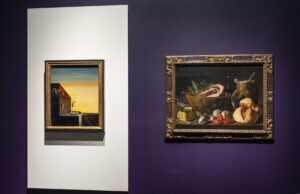
In “Eggs on the Plate Without the Plate,” fig. 2, the egg becomes a hanging figure, at once pitiful and ridiculous, and finally hanging in one’s mind as an image of contemporary violence and crime.
How these paintings work with the larger theme escapes me. The exhibit’s aim is to show how he engaged with the past, and throughout the installation individual works are paired with old masters. There is justification for this approach. In 1919 Dali wrote essays on Durer, Michelangelo and others and urged artists to “Begin by drawing and painting like the old masters.” (An early self-portrait from 1918 was painted in a Fauvist style, although the Fauves were hardly old masters at that point).
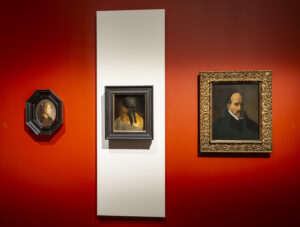
A pairing of a bust of a woman seen from the back paired with a Velasquez self-portrait only makes clear that very few artists can stand up to Velasquez. Still, technically, Dali does have incredible skill, which does indicate he tutored himself in that way.
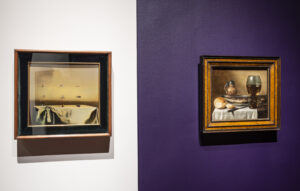
Dalí: Disruption and Devotion
However, perhaps due to lack of patience, I could not see how many of the older works chimed with Dali’s.
One of the few exceptions was an amazing anonymous engraving, “The Temptation of St. Anthony,” f from 1556, with a severed head topped by a gutted fish, and with a diminutive St. Anthony cowering and praying in the corner. It was truly Surreal! In addition, the “Seven Deadly Sins” mid-16th century portfolio of engravings by Pieter van der Hayden was certainly Surrealist before the fact.
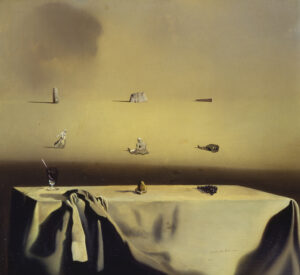
fig 3 Morphological Echo
Again, one major take-away for me was the impressive level of Dali’s technical skill that made mundane seeming paintings memorable. In “Morphological Echo,” from 1936, tiny images of highly detailed landscapes and sculptures float up from a table—a still life that is not still at all. A small painting of a piano on a beach from 1934 looks almost silly, again until viewed closely and in conjunction with its bizarre title, “Atmospheric Skull Sodomizing a Grand Piano.”
Dali claimed early on that “The world needs more fantasy.” In the age of the internet, that fantasy has often become misinformation and we hardly need more of it. But the imagination to re-think and re-see? That Dali can offer us.
List of Figures—all images by Dali unless otherwise noted
- The Disintegration of the Persistence of Memory,1952-54
Oil on canvas
* Collection of The Dalí Museum, St. Petersburg, FL (USA); Gift of A. Reynolds & Eleanor Morse
* Courtesy Museum of Fine Arts, Boston - The Ecumenical Council, 1960
Oil on canvas
* Collection of The Dalí Museum, St. Petersburg, FL (USA); Gift of
A. Reynolds & Eleanor Morse
* © 2024 Salvador Dalí, Fundació Gala-Salvador Dalí, Artists Rights Society
* Photo © Doug Sperling and David Deranian, 2021 |
* Courtesy Museum of Fine Arts, Boston - Oeufs sur le Plat sans le Plat 1932
Oil on canvas
* Collection of The Dalí Museum, St. Petersburg, FL (USA); Gift of
A. Reynolds & Eleanor Morse
* © 2024 Salvador Dalí, Fundació Gala-Salvador Dalí, Artists Rights Society
* Photo © David Deranian, 2021 |
* Courtesy Museum of Fine Arts, Boston - Morphological Echo, 1936
Oil on wood panel
* Collection of The Dalí Museum, St. Petersburg, FL (USA); Gift of
A. Reynolds & Eleanor Morse
* © 2024 Salvador Dalí, Fundació Gala-Salvador Dalí, Artists Rights Society
* Courtesy Museum of Fine Arts, Boston - All installation shots courtesy of Museum of Fine Arts
This entry was posted on July 26, 2024 and is filed under Uncategorized.


